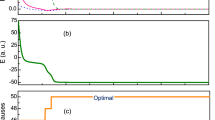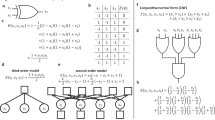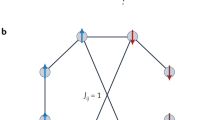Abstract
The past decade has seen the emergence of Ising machines targeting hard combinatorial optimization problems by minimizing the Ising Hamiltonian with spins represented by continuous dynamical variables. However, capabilities of these machines at larger scales are yet to be fully explored. We introduce and investigate an almost-linear Ising machine, a machine based on a network of analog spins with piece-wise linear coupling. We show that such networks leverage the computational resource similar to that of the semidefinite positive relaxation of the Ising model. We estimate the expected performance of the almost-linear machine and benchmark it on a set of \(\left\{ 0, 1\right\}\)-weighted graphs. We show that the running time of the investigated machine scales polynomially (linearly with the number of edges in the connectivity graph). As an example of the physical realization of the machine, we present a CMOS-compatible implementation comprising an array of vertices efficiently storing the continuous spins on charged capacitors and communicating externally via analog current.








Similar content being viewed by others
Availability of data and materials
The graphs used to obtain Fig. 4 are generic and can be generated using the code referred below. The specific running time values may differ depending on the computer performance and running conditions. However, the estimated scaling, which is the main result of Fig. 4, does not depend on the computer performance as long as the same running conditions are ensured for different graphs.The specific datasets depicted on the manuscript figures are available from the corresponding author on reasonable request.
Code availability
The code of Circut is available at https://www.caam.rice.edu/~zhang/circut/. The code used for simulating the almost-linear Ising machine and generating the supporting data is available at https://github.com/merement/Dice/tree/main/cases/triangular.
References
Babbush R, Perdomo-Ortiz A, O’Gorman B, Macready W, Aspuru-Guzik A (2014) Construction of energy functions for lattice heteropolymer models: efficient encodings for constraint satisfaction programming and quantum annealing. 201–244. https://doi.org/10.1002/9781118755815.ch05
Fraenkel AS (1993) Complexity of protein folding. Bull Math Biol 55(6):1199–1210. https://doi.org/10.1007/BF02460704
Wang J, MacKenzie JD, Ramachandran R, Zhang Y, Wang H, Chen DZ (2015) Segmenting subcellular structures in histology tissue images. In: 2015 IEEE 12th international symposium on biomedical imaging (ISBI), pp 556–559. https://doi.org/10.1109/ISBI.2015.7163934
Barahona F (1982) On the computational complexity of Ising spin glass models. J Phys A Math Gen 15(10):3241–3253. https://doi.org/10.1088/0305-4470/15/10/028
Karp RM (1972) Reducibility among combinatorial problems. In: Miller RE, Thatcher JW, Bohlinger JD (eds) Complexity of computer computations. Springer, Boston, pp 85–103. https://doi.org/10.1007/978-1-4684-2001-2_9
Garey MR, Johnson DS, Stockmeyer L (1976) Some simplified NP-complete graph problems. Theoret Comput Sci 1(3):237–267. https://doi.org/10.1016/0304-3975(76)90059-1
Lucas A (2014) Ising formulations of many NP problems. Front Phys 2:5. https://doi.org/10.3389/fphy.2014.00005
Kirkpatrick S, Gelatt CD, Vecchi MP (1983) Optimization by simulated annealing. Science 220(4598):671–680. https://doi.org/10.1126/science.220.4598.671
Yamaoka M, Yoshimura C, Hayashi M, Okuyama T, Aoki H, Mizuno H (2015) 20k-spin Ising chip for combinational optimization problem with CMOS annealing. In: Digest of technical papers—IEEE international solid-state circuits conference, vol 58, pp 432–433. https://doi.org/10.1109/ISSCC.2015.7063111
Takemoto T, Hayashi M, Yoshimura C, Yamaoka M (2020) A 2 x 30k-spin multi-chip scalable CMOS annealing processor based on a processing-in-memory approach for solving large-scale combinatorial optimization problems. IEEE J Solid-State Circuits 55(1):145–156. https://doi.org/10.1109/JSSC.2019.2949230
Su Y, Kim H, Kim B (2020) 31.2 CIM-Spin: A 0.5-to-1.2V scalable annealing processor using digital compute-in-memory spin operators and register-based spins for combinatorial optimization problems. In: 2020 IEEE international solid-state circuits conference—(ISSCC), pp 480–482. https://doi.org/10.1109/ISSCC19947.2020.9062938
Takemoto T, Yamamoto K, Yoshimura C, Hayashi M, Tada M, Saito H, Mashimo M, Yamaoka M (2021) 4.6 A 144kb annealing system composed of \(9\times\)16Kb annealing processor chips with scalable chip-to-chip connections for large-scale combinatorial optimization problems. In: 2021 IEEE international solid-state circuits conference (ISSCC), vol 64, pp 64–66. https://doi.org/10.1109/ISSCC42613.2021.9365748
Okuyama T, Yoshimura C, Hayashi M, Yamaoka M (2016) Computing architecture to perform approximated simulated annealing for Ising models. In: 2016 IEEE international conference on rebooting computing (ICRC), pp 1–8. https://doi.org/10.1109/ICRC.2016.7738673
Yamamoto K, Huang W, Takamaeda-Yamazaki S, Ikebe M, Asai T, Motomura M (2017) A time-division multiplexing Ising machine on FPGAs. In: ACM international conference proceeding series. https://doi.org/10.1145/3120895.3120905
Ahmed I, Chiu PW, Moy W, Kim CH (2021) A probabilistic compute fabric based on coupled ring oscillators for solving combinatorial optimization problems. IEEE J Solid-State Circuits. https://doi.org/10.1109/JSSC.2021.3062821
Bashar MK, Mallick A, Truesdell DS, Calhoun BH, Joshi S, Shukla N (2020) Experimental demonstration of a reconfigurable coupled oscillator platform to solve the max-cut problem. IEEE J Explor Solid-State Comput Devices Circuits 6(2):116–121. https://doi.org/10.1109/JXCDC.2020.3025994
Parihar A, Shukla N, Jerry M, Datta S, Raychowdhury A (2017) Vertex coloring of graphs via phase dynamics of coupled oscillatory networks. Sci Rep 7(1):911. https://doi.org/10.1038/s41598-017-00825-1
Raychowdhury A, Parihar A, Smith GH, Narayanan V, Csaba G, Jerry M, Porod W, Datta S (2019) Computing with networks of oscillatory dynamical systems. Proc IEEE 107(1):73–89. https://doi.org/10.1109/JPROC.2018.2878854
Marandi A, Wang Z, Takata K, Byer RL, Yamamoto Y (2014) Network of time-multiplexed optical parametric oscillators as a coherent Ising machine. Nat Photonics 8(12):937–942. https://doi.org/10.1038/nphoton.2014.249
McMahon PL, Marandi A, Haribara Y, Hamerly R, Langrock C, Tamate S, Inagaki T, Takesue H, Utsunomiya S, Aihara K, Byer RL, Fejer MM, Mabuchi H, Yamamoto Y (2016) A fully programmable 100-spin coherent Ising machine with all-to-all connections. Science 354(6312):614–617. https://doi.org/10.1126/science.aah5178
Böhm F, Verschaffelt G, Van der Sande G (2019) A poor man’s coherent Ising machine based on opto-electronic feedback systems for solving optimization problems. Nat Commun 10(1):3538. https://doi.org/10.1038/s41467-019-11484-3
Leleu T, Yamamoto Y, Utsunomiya S, Aihara K (2017) Combinatorial optimization using dynamical phase transitions in driven-dissipative systems. Phys Rev E 95(2):4–6. https://doi.org/10.1103/PhysRevE.95.022118
Molnár B, Molnár F, Varga M, Toroczkai Z, Ercsey-Ravasz M (2018) A continuous-time MaxSAT solver with high analog performance. Nat Commun 9(1):1–12. https://doi.org/10.1038/s41467-018-07327-2
Afoakwa R, Zhang Y, Vengalam UKR, Ignjatovic Z, Huang M (2021) BRIM: bistable resistively-coupled Ising machine. In: 2021 IEEE international symposium on high-performance computer architecture (HPCA). IEEE, Seoul, pp 749–760. https://doi.org/10.1109/HPCA51647.2021.00068
Gset: Group of Random Graphs. https://sparse.tamu.edu/Gset
Papadimitriou CH, Yannakakis M (1991) Optimization, approximation, and complexity classes. J Comput Syst Sci 43(3):425–440. https://doi.org/10.1016/0022-0000(91)90023-X
Håstad J (2001) Some optimal inapproximability results. J ACM 48(4):798–859. https://doi.org/10.1145/502090.502098
Khot S (2010) On the unique games conjecture (invited survey). In: 2010 IEEE 25th annual conference on computational complexity, pp 99–121. https://doi.org/10.1109/CCC.2010.19
Trevisan L (2012) On Khot’s unique games conjecture. Bull Am Math Soc 49(1):91–111. https://doi.org/10.1090/S0273-0979-2011-01361-1
Khot S, Kindler G, Mossel E, O’Donnell R (2004) Optimal inapproximability results for max-cut and other 2-variable CSPs? In: 45th annual IEEE symposium on foundations of computer science. IEEE, Rome, pp. 146–154. https://doi.org/10.1109/FOCS.2004.49
...Hamerly R, Inagaki T, McMahon PL, Venturelli D, Marandi A, Onodera T, Ng E, Langrock C, Inaba K, Honjo T, Enbutsu K, Umeki T, Kasahara R, Utsunomiya S, Kako S, Kawarabayashi K-I, Byer RL, Fejer MM, Mabuchi H, Englund D, Rieffel E, Takesue H, Yamamoto Y (2019) Experimental investigation of performance differences between coherent Ising machines and a quantum annealer. Sci Adv 5(5):0823. https://doi.org/10.1126/sciadv.aau0823
Leleu T, Khoyratee F, Levi T, Hamerly R, Kohno T, Aihara K (2021) Scaling advantage of chaotic amplitude control for high-performance combinatorial optimization. Commun Phys 4(1):266. https://doi.org/10.1038/s42005-021-00768-0
Erementchouk M, Shukla A, Mazumder P (2022) On computational capabilities of Ising machines based on nonlinear oscillators. Physica D 437:133334. https://doi.org/10.1016/j.physd.2022.133334
Adler R (1946) A study of locking phenomena in oscillators. Proc IRE 34(6):351–357. https://doi.org/10.1109/JRPROC.1946.229930
Bhansali P, Roychowdhury J (2009) Gen-Adler: the generalized Adler’s equation for injection locking analysis in oscillators. In: 2009 Asia and South Pacific design automation conference. IEEE, Yokohama, pp 522–527. https://doi.org/10.1109/ASPDAC.2009.4796533
Korte B, Vygen J (2018) Combinatorial optimization. Algorithms and Combinatorics. Springer, Berlin, Heidelberg, vol 21. https://doi.org/10.1007/978-3-662-56039-6
Goemans MX, Williamson DP (1995) Improved approximation algorithms for maximum cut and satisfiability problems using semidefinite programming. J ACM 42(6):1115–1145. https://doi.org/10.1145/227683.227684
Alon N, Sudakov B (2000) Bipartite subgraphs and the smallest eigenvalue. Comb Probab Comput 9(1):1–12. https://doi.org/10.1017/S0963548399004071
Deza MM, Laurent M (1997) Geometry of cuts and metrics. In: Algorithms and Combinatorics. Springer, Berlin, Heidelberg, vol 15. https://doi.org/10.1007/978-3-642-04295-9
Burer S, Monteiro RDC, Zhang Y (2002) Rank-two relaxation heuristics for MAX-CUT and other binary quadratic programs. SIAM J Optim 12(2):503–521. https://doi.org/10.1137/S1052623400382467
Laurent M, Poljak S (1995) On a positive semidefinite relaxation of the cut polytope. Linear Algebra Appl 223–224:439–461. https://doi.org/10.1016/0024-3795(95)00271-R
Charikar M, Wirth A (2004) Maximizing quadratic programs: extending grothendieck’s inequality. In: 45th annual IEEE symposium on foundations of computer science. IEEE, Rome, pp 54–60. https://doi.org/10.1109/FOCS.2004.39
Alon N, Naor A (2004) Approximating the cut-norm via Grothendieck’s inequality. In: Proceedings of the thirty-sixth annual acm symposium on theory of computing—STOC ’04. ACM Press, Chicago, p 72. https://doi.org/10.1145/1007352.1007371
Anjos MF, Wolkowicz H (2002) Strengthened semidefinite relaxations via a second lifting for the max-cut problem. Discret Appl Math 119(1–2):79–106. https://doi.org/10.1016/S0166-218X(01)00266-9
Razavi B (2002) Design of analog CMOS integrated circuits. Tata McGraw-Hill, p 684
Funding
The work has been supported by the US National Science Foundation (NSF) under Grant No. 1710940 and by the US Air Force Office of Scientific Research (AFOSR) under Grant No. FA9550-16-1-0363.
Author information
Authors and Affiliations
Contributions
All authors contributed to the study conception. AS designed and simulated the custom integrated circuit. ME performed the theoretical analysis and its software validation. Both ME and AS collectively drafted the manuscript. PM supervised the project and revised the manuscript. All authors read and gave approval to the final version of the manuscript.
Corresponding author
Ethics declarations
Conflict of interest
The authors have no Conflict of interest to declare that are relevant to the content of this article.
Additional information
Publisher's Note
Springer Nature remains neutral with regard to jurisdictional claims in published maps and institutional affiliations.
Rights and permissions
Springer Nature or its licensor (e.g. a society or other partner) holds exclusive rights to this article under a publishing agreement with the author(s) or other rightsholder(s); author self-archiving of the accepted manuscript version of this article is solely governed by the terms of such publishing agreement and applicable law.
About this article
Cite this article
Shukla, A., Erementchouk, M. & Mazumder, P. Scalable almost-linear dynamical Ising machines. Nat Comput (2024). https://doi.org/10.1007/s11047-024-09983-4
Accepted:
Published:
DOI: https://doi.org/10.1007/s11047-024-09983-4




